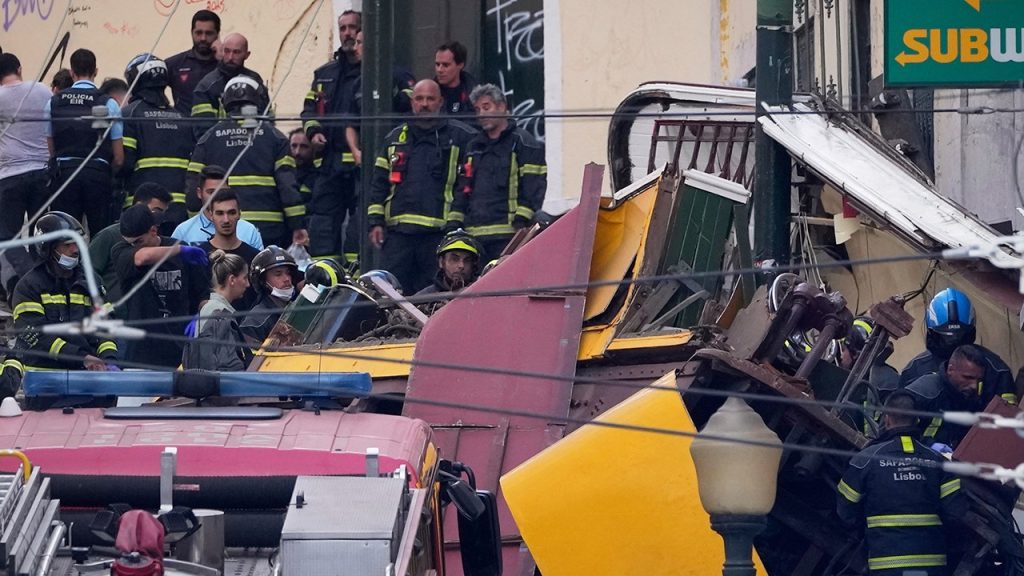Tragedy on Lisbon’s Historic Funicular: A Community in Mourning
In a devastating accident that has shaken Portugal to its core, Lisbon’s beloved Glória Funicular derailed during Wednesday’s rush hour, claiming at least 15 lives and leaving 18 others injured, including a child. The historic cable-pulled tram, which has been ferrying residents and tourists up Lisbon’s steep hills since 1885, came off its tracks before crashing into a nearby building. The accident has transformed one of the city’s most cherished landmarks into the site of unprecedented tragedy, leaving families shattered and a nation in mourning. Early investigations suggest a loose cable may have been responsible for the derailment, though authorities have launched a full probe to determine the exact cause of the mechanical failure.
The Glória Funicular is more than just a mode of transportation for Lisbon—it’s a living piece of history, connecting the bustling downtown area with the elevated Bairro Alto district. For generations, the distinctive yellow tram has been woven into the daily lives of locals while simultaneously enchanting thousands of visitors each year with its charming vintage appearance and spectacular hillside views. On the day of the accident, the funicular was filled with its usual mix of morning commuters and eager sightseers, none suspecting the tragedy that would unfold. The accident has not only taken lives but has also struck at the heart of Lisbon’s cultural identity, transforming a symbol of the city’s rich heritage into a reminder of its darkest day.
Emergency services responded with remarkable speed, arriving at the scene within minutes of the derailment. Medical teams worked tirelessly amid the chaos, providing immediate care to the injured before transporting them to nearby hospitals. The scene was described by witnesses as chaotic and heartbreaking, with first responders doing everything possible to rescue those trapped in the wreckage. The community’s response has been equally swift, with local residents rushing to offer assistance, comfort to survivors, and support to the emergency personnel working under immense pressure. In the hours following the accident, nearby buildings were converted into temporary aid stations, and countless Lisbon residents volunteered to help in any way they could, demonstrating the profound solidarity that often emerges in the wake of disaster.
Portuguese President Marcelo Rebelo de Sousa quickly addressed the nation, expressing profound grief and extending heartfelt condolences to the families who lost loved ones. “It’s a tragedy of the like we’ve never seen,” he stated, his voice heavy with emotion as he pledged complete transparency in the official investigation. The President’s words reflected the shock felt across Portugal, where the funicular accident represents one of the country’s worst transportation disasters in recent memory. The government has declared a national day of mourning, acknowledging that the accident “caused the irreparable loss of human life, which left in mourning their families and dismayed the whole country.” This formal recognition underscores the profound impact of the tragedy on Portugal’s national consciousness.
Questions about maintenance and safety protocols have emerged in the aftermath of the derailment, with local media reporting concerns over recent maintenance schedules. For many residents, these questions are particularly painful given the funicular’s status as a national treasure that has operated safely for over a century. Transportation officials have promised a thorough examination of all similar systems throughout the country, while engineering experts have been called in to assist with the investigation. The tragedy has sparked a broader conversation about the challenges of maintaining historic infrastructure while ensuring modern safety standards. For now, the other funiculars and historic trams in Lisbon remain suspended as officials conduct emergency inspections, leaving many commuters to find alternative routes while also providing space for collective grief.
The human toll of this tragedy extends far beyond the immediate victims. Family members gathered at local hospitals, anxiously awaiting news of their loved ones, while others faced the unbearable task of identifying the deceased. Throughout Lisbon, impromptu memorials have appeared near the accident site, adorned with flowers, candles, and personal messages—a testament to how deeply this tragedy has affected the community. Tourists who witnessed the accident described scenes of strangers comforting one another, regardless of language barriers or nationality. Local schools and businesses have organized support groups for those traumatized by what they saw, while mental health professionals have volunteered their services to help the community process its collective grief. As Lisbon begins the difficult process of healing, the accident serves as a somber reminder of both the fragility of life and the strength found in community during times of unimaginable loss.


